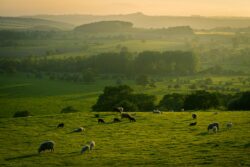Kentucky Bluegrass, a perennial, cool-season grass, is a staple in pastures across various regions, particularly in the central, northern, and northeastern United States.
Its popularity among farmers and grazers stems from a unique combination of traits that cater to both the land’s health and the nutritional needs of grazing animals.
Advantages of Kentucky Bluegrass in Pastures
High-Quality Forage: Kentucky Bluegrass is known for its high palatability and nutritional value, making it an excellent choice for grazing animals. Its ability to provide a consistent and quality food source is a significant advantage.
Sod Formation: Unlike other cool-season grasses, Kentucky Bluegrass spreads through rhizomes, underground stems that grow horizontally and help fill in open areas. This characteristic allows it to form a dense sod, which is beneficial for erosion control and maintaining soil health.
Grazing Tolerance: This grass tolerates close and frequent grazing better than most species. Its resilience and rapid recovery from grazing pressure make it ideal for pastures that are continuously grazed.
Environmental Adaptation: Kentucky Bluegrass thrives in cool, moist weather and well-drained, fertile soils with a pH between 6 and 7. It’s well-adapted to areas where the average daily temperature during July does not exceed 75°F, making it suitable for the north central and northeastern regions.
Challenges and Considerations
While Kentucky Bluegrass offers numerous benefits, it also presents some challenges:
- Low Summer Production: It becomes semi-dormant during hot, dry summers, leading to reduced productivity.
- Susceptibility to Pests: More prone to grub and insect damage compared to other pasture grasses.
- Slow Establishment: Takes longer to establish than some other grasses, requiring patience and proper seeding techniques.
Establishing Kentucky Bluegrass in Pastures
For optimal establishment, seeding in late summer or early fall is recommended, utilizing a seeding rate of 10-15 pounds per acre.
This timing takes advantage of cooler temperatures and more frequent rainfall, which are conducive to the grass’s growth.
Mixing Kentucky Bluegrass with legumes like white clover can enhance the pasture’s nutritional value and extend the grazing season.
Management and Utilization
Proper fertilization, especially nitrogen application in late winter and late summer, can significantly boost Kentucky Bluegrass’s yield.
Additionally, maintaining a balanced mixture of grass and legumes in the pasture can improve forage quality and soil health.
In Summary
- Kentucky Bluegrass is favored in pastures for its high-quality forage, dense sod formation, and tolerance to close grazing.
- It thrives in cool, moist conditions and is best seeded in late summer or early fall for optimal establishment.
- Despite its advantages, it requires careful management to overcome challenges like low summer productivity and susceptibility to pests.
Sources and Further Reading
- University of Kentucky Forages: Provides detailed insights into the advantages and uses of Kentucky Bluegrass in pastures.
- Penn State Extension: Offers comprehensive information on the characteristics, establishment, and management of Kentucky Bluegrass.
- University of Kentucky College of Agriculture: Discusses Kentucky Bluegrass as a forage crop, highlighting its benefits and management practices for optimal pasture health.




